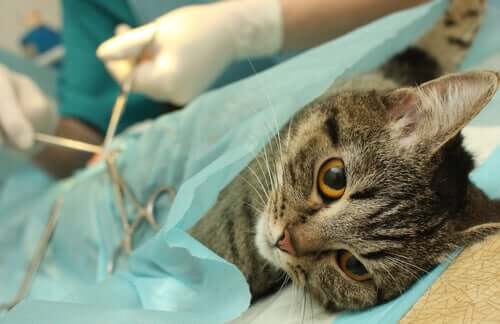Cat Neutering and Spaying: Is it Safe and Necessary?

Having a pet is highly beneficial to humans. Unfortunately, cats who seldom get out of their home have an increased libido as a consequence. The way in which they express it can be quite annoying for both you and them. So, in such a scenario, cat neutering or spaying is your best course of action as it’ll help calm down the animal. That, in turn, will make your life together a lot more bearable for both of you.
In addition, it helps prevent unwanted pregnancies, calms anxiety and, as a result, will reduce the animal’s aggressiveness. Sterilization can be good for both males and females. In addition, many medical conditions are a lot easier to prevent when you opt for this intervention. Not to forget how overpopulation of stray cats is a current world problem.
This kind of surgery is completely different for male and female cats. For this reason, we’re dividing the information into two sections in order to analyze each one. That way you can see how it may impact each of the cat genders.
Cat neutering and spaying

Neutering is for males
Neutering is a procedure performed on male cats. It’s highly recommended because testicular cancer is a lot more common in animals who don’t have sex periodically. This type of condition is a lot more common than you may think.
The levels of testosterone produced by a non-neutered male cat are very high and can lead to other health problems such as adenomas, prostatitis, and benign prostatic hyperplasia, among others.
To sterilize a cat, vets perform an orchiectomy —the removal of both testicles. By doing this simple surgical procedure the main source of hormones in cats is also removed and it also reduces the sexual frustration an animal may have for not having any contact with females.
In order to neuter, it’s imperative to put the cat to sleep with the aid of general anesthesia. Having said that, it’s a pretty straight forward procedure that carries little to no risk. In addition, the cat should skip its previous night’s meal in order for everything to go smoothly with no complications.
As a general rule, cats don’t usually spend the night in a clinic for this procedure. The incision required to remove the testicles is very small and doesn’t even require stitches. Cat neutering is very similar to dog neutering. In fact, it’s even simpler because the incision is usually a lot smaller.
Spaying is for females

As for the diseases that you can prevent when spaying your female cat, the most common are those related to the uterus and the ovaries. Polycystic ovaries, cancer and pyometra, among others.
This procedure is a lot more complex in females than in males. It’s only because the female cat’s reproductive organs are internal. So, in order to perform it, the vet needs to remove the ovaries and the uterus while the cat is sedated under general anesthesia.
In this case, the female cat does need stitches because the size of the incision is larger. However, if everything goes well, they can go back home on the same day of the surgery.
Then, the cat must go back to the vet about 8 to 10 days after the intervention in order to remove the stitches. There are times when the wound may ooze intradermally, and so the body absorbs the stitches and the cat doesn’t have to go back to the clinic at all. Unless there’s an infection, that is.
Cat neutering and spaying: conclusion
As you can see, the benefits of neutering and spaying your cat are many. More than anything you’ll appreciate the end of those continuous, eerie meows during the cat’s heat season.
It’s truly annoying to have a non-sterilized cat locked up inside your house. However, you should know that there are times when this surgical procedure doesn’t entirely mean the meows will disappear 100%. Still, they’re considerably reduced.
There are many moral and ethical positions on whether a cat should be sterilized. As there are on whether they should live inside a house or not. If you ask a professional they’ll most likely tell you to go for it in order to avoid the many aforementioned diseases. However, as with everything, there are pros and cons to this decision.
If you decide to do it, just be careful with their diet as sterilized cats tend to get fatter when they get more relaxed and start enjoying their sedentary life. Of course, a diet is a lot easier to control than a cat on heat.
All cited sources were thoroughly reviewed by our team to ensure their quality, reliability, currency, and validity. The bibliography of this article was considered reliable and of academic or scientific accuracy.
Nutro expertos. 14 noviembre 2016. Castrar a un gato: todo lo que necesitas saber.
- nutroexpertos.com/castrar-gato-lo-que-necesitas-saber/?cn-reloaded=1
Purina PRO Plan. La castración del gato.
- purina.es/gato/pro-plan/consejos/cuidados-para-la-salud/la-castracion-del-gato-cuando-hacerlo-y-las-ventajas-de-esterilizar
Plataforma gatera. Fuente Gemfe. Esterilización del gato.
- http://plataformagatera.org/post-6-esterilizacion-del-gato
This text is provided for informational purposes only and does not replace consultation with a professional. If in doubt, consult your specialist.